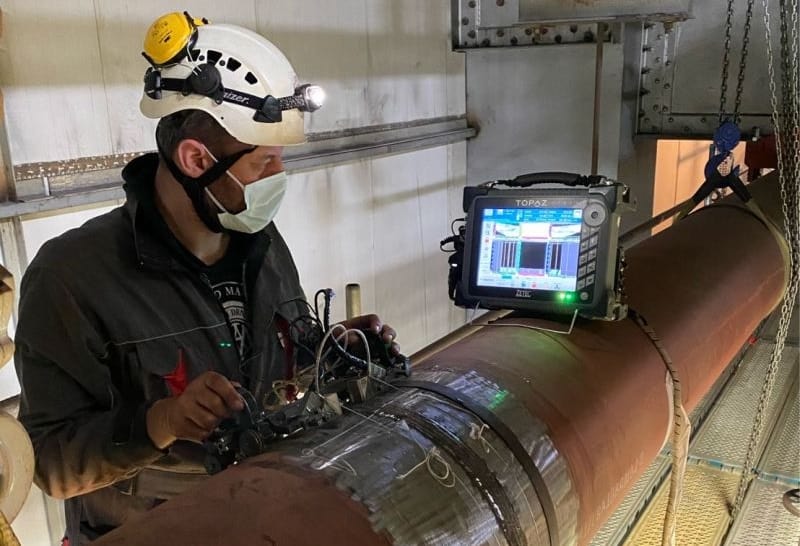Comprehensive Review of Pipe Welding Inspection Procedures
In the world of pipe construction, guaranteeing the integrity and security of welded joints is paramount. Pipeline welding inspection procedures play an essential duty in ensuring that welded links fulfill rigid sector requirements and specifications. From meticulous pre-welding inspections to comprehensive post-weld assessments, a distinct evaluation procedure is crucial for maintaining the structural sturdiness of pipelines. Comprehending the complexities of welding assessment treatments is not just a governing demand yet likewise a fundamental aspect of upholding the dependability of these crucial infrastructures.
Pre-welding Examination Preparations
Before beginning the welding process, thorough pre-welding examination prep work are vital to make certain the honesty and top quality of the weld joint. These prep work entail a careful examination of the materials to be welded, the welding equipment, and the work atmosphere. By carrying out comprehensive pre-welding evaluation prep work, potential concerns can be recognized and dealt with early on, leading to reliable and top quality weld joints.
Welding Procedure Credentials
Complete pre-welding inspection preparations lay the structure for the vital process of Welding Procedure Credentials, guaranteeing the honesty and quality of the weld joint. Welding Treatment Qualification (WPQ) is a crucial step in the welding process that involves screening and accrediting welding treatments to assure they meet details requirements and needs. The WPQ process commonly consists of welding procedure requirements growth, welding procedure credentials testing, and documents of the outcomes.
During welding procedure specification advancement, necessary information such as the welding process, welding products, joint style, and welding criteria are specified to develop a detailed treatment. Consequently, welding procedure qualification screening is performed to confirm the proposed treatment's integrity. This testing often involves welding test coupons that undergo different mechanical and non-destructive tests to examine the weld's top quality and adherence to the defined requirements.
In-process Weld Assessment
Throughout the welding procedure, in-process weld inspection plays a vital duty in guaranteeing the high quality and integrity of the weld joint - Pipeline Welding Inspection. This kind of evaluation entails keeping an eye on the welding parameters, evaluating the weld grain development, and discovering any kind of prospective problems or stoppages as they occur. By carrying out in-process weld evaluations, welding drivers can immediately deal with any type of concerns that might develop, therefore preventing further problems and making sure that the final weld fulfills the required requirements
Usual approaches utilized for more information in-process weld evaluation include aesthetic assessment, fluid penetrant screening, magnetic fragment screening, ultrasonic testing, and radiographic screening. Generally, in-process weld examination is necessary for keeping the high quality and reliability of bonded pipes.
Non-destructive Testing (NDT)
Non-destructive Screening (NDT) is an important method used in pipeline welding inspection to assess the honesty of weld joints without creating damage to the bonded structure. By making use of numerous NDT strategies, inspectors can assess the top quality of welds and determine any issues or stoppages that may endanger the structural soundness of the pipe. Typical NDT approaches made use of in pipe welding evaluation include Radiographic Screening (RT), Ultrasonic Screening (UT), Magnetic Fragment Checking (MPT), Fluid Penetrant Testing (LPT), and Visual Testing (VT)
RT involves the usage of X-rays or gamma rays to create photos of the interior structure of the weld, enabling assessors to detect issues such as porosity, fractures, or incomplete combination. In addition, VT involves aesthetic evaluation of welds to recognize any kind of noticeable imperfections.
Post-weld Evaluation and Paperwork


Documents of post-weld assessment findings is necessary for keeping quality assurance records and making certain conformity with industry requirements and laws. In-depth records must consist of details regarding the evaluation techniques used, the location and nature of any defects located, and any type of corrective actions taken - Pipeline Welding Inspection. Correct documents not just functions as a document of the weld's high quality yet likewise help in future upkeep and inspection procedures
Final Thought

In verdict, pipe welding evaluation treatments play a vital role in ensuring the quality and integrity of welds. From pre-welding assessments to post-weld documents, each action is crucial in keeping the safety and security and efficiency of pipes. By complying with Extra resources well-known procedures and performing thorough evaluations, prospective defects can be recognized and resolved before they lead to costly repair services or failings. In general, adherence to correct evaluation protocols is key to the success of pipe welding jobs.
From thorough pre-welding evaluations to thorough post-weld evaluations, a well-defined inspection procedure is essential for keeping the structural stability of pipes. By carrying out in-process weld examinations, welding drivers can without delay resolve any kind of issues that might develop, therefore making certain and preventing additional defects that the last weld fulfills the needed specifications.
Typical methods used for in-process weld inspection consist of visual examination, liquid penetrant screening, magnetic particle screening, ultrasonic screening, helpful hints and radiographic screening.Non-destructive Testing (NDT) is an essential approach used in pipe welding inspection to evaluate the honesty of weld joints without triggering damages to the bonded structure. Post-weld assessment includes different approaches to analyze the welds for problems, consisting of aesthetic assessment, color penetrant testing, magnetic particle screening, ultrasonic testing, and radiographic screening.